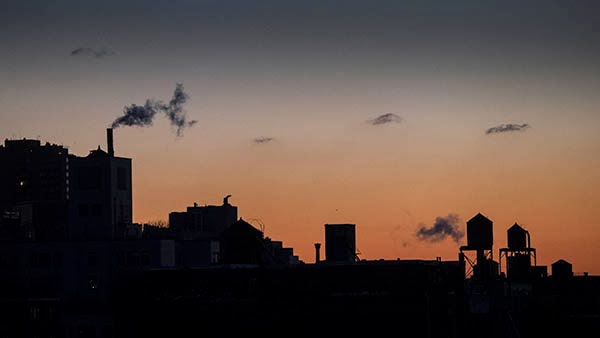One of my favorite lenses for still life photography is the Nikon 85mm tilt-shift macro. I like working my lenses with wide open apertures, but at close distances where the depth of field is at it narrowest I often lose too much detail in the subject. Stopping the lens down increases the depth of field for to include more in focus, but it also destroys the totally out of focus bokeh of a wide open aperture. The tilt shift lens allows me to selectively include more areas in focus while still maintaining a wide open aperture and good bokeh.
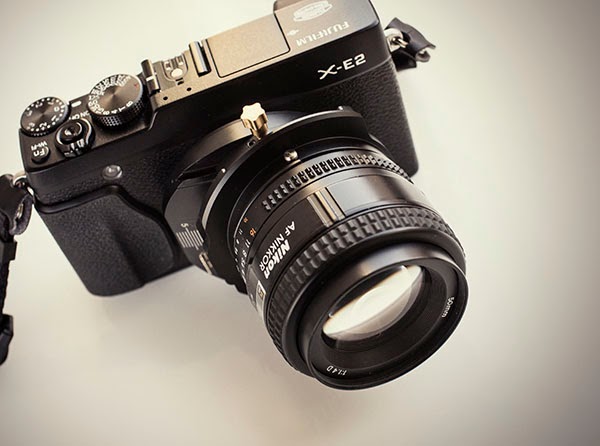 |
| A Fuji X-E2 with Kipon tilt-shift adapter and Nikon 50mm f/1.4 D lens. It is in full tilt position. |
I often do a lot of spontaneous still life photos at home where I have a soft window light, but I keep my Nikon tilt-shift at the studio. On ebay I found a tilt-shift adapter made by Kipon to fit the Fuji X cameras. Kipon makes a several models for adapting a variety of lens types. I was interested in the Nikon to Fuji X series, which I wanted to use with 50mm and 35mm Nikon D lenses, and a 60mm Nikon macro giving me effective focal lengths of 75mm, 50mm, and 90mm on my Fuji X-E2. The adapter also comes in a Nikon G mount which adds aperture control.
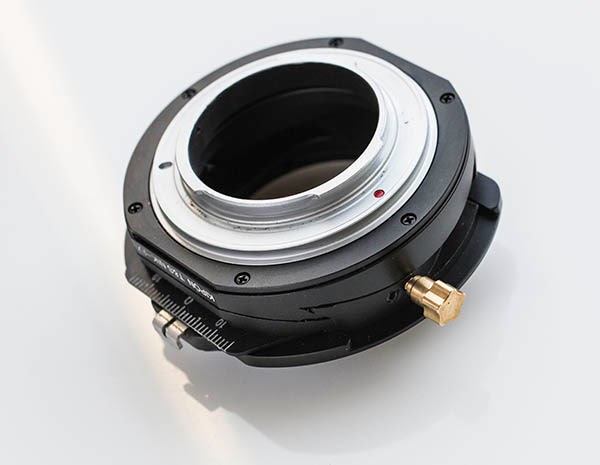 |
| The Kipon tilt-shift adapter in closed position. |
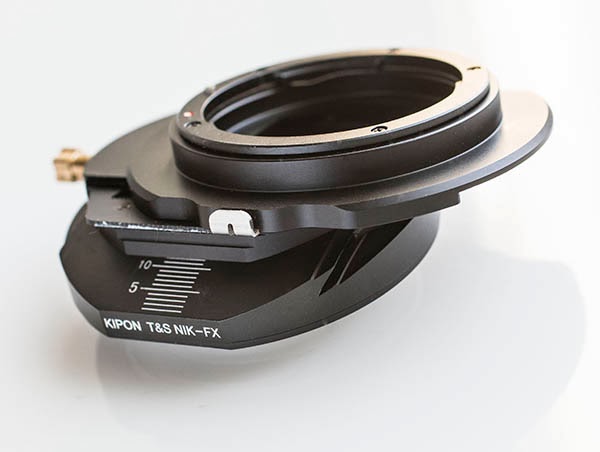 |
| Here the adapter has a full shift to the right and full tilt away from us. See below for how this looks on the camera with lens attached. |
The Kipon adapter has a maximum tilt of 12° and maximum shift of 15mm. The lens will still focus to infinity on the adapter, but there is no pass through of any information from the lens. As a result there is no auto-focus so the lens must be use in manual focus, which is typical for tilt/shift lenses in general. The adapter rotates 360° enabling you to place the tilt anywhere, even on an angle.
The brass knob on the side of the adapter is to tighten the tilt movement in place once it has been set. To adjust the tilt, you loosen the brass knob and slide the lens to down. It only moves in one direction.
The significant drawback to this adapter is that the tilt movement and shift movement are not independent of each other. They must be rotated together.
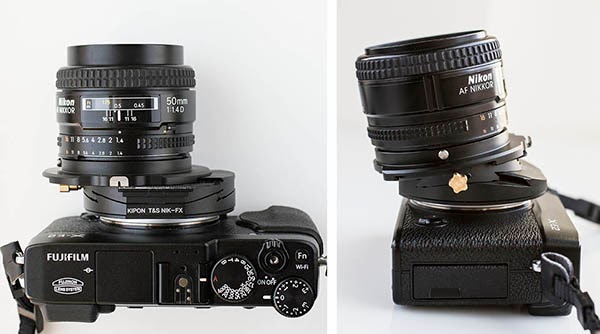 |
| On the left the lens has a full shift to the left. On the right the lens has a full tilt downward. |
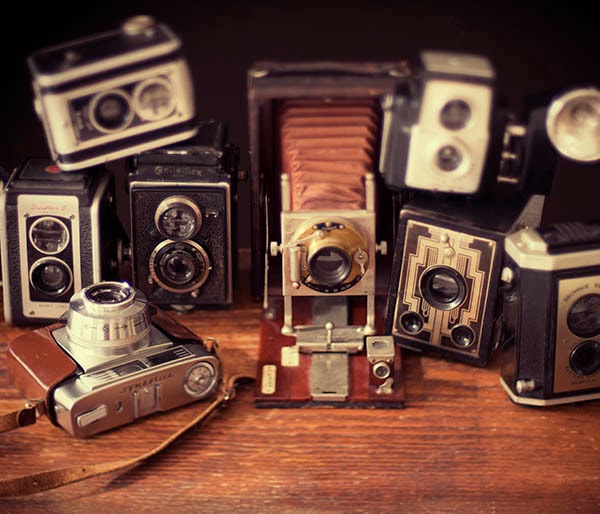 |
| With the 50mm Nikkor mounted on the adapter and set to f/1.4 there the depth of field is very narrow at such a close distance. For the photo below I still kept the aperture set to f/1.4 but tilted the lens forward to change the plain of focus so it would include some of the background cameras. Several areas are still soft, but that is the effect I want. |
Below are two photos I took to illustrate the extremes of tilting the lens. The top photo was taken with a Nikon 50mm f/1/4 lens at f/1.4 and no tilt on the adapter. The photo below it is shot with the same lens and aperture, but with a forward tilt of the adapter to include more focus in the background while still leaving some selective out of focus areas. These are the two extremes. In normal use I pick something in between these two, usually with a slight tilt to include just a bit more story-telling detail in focus.
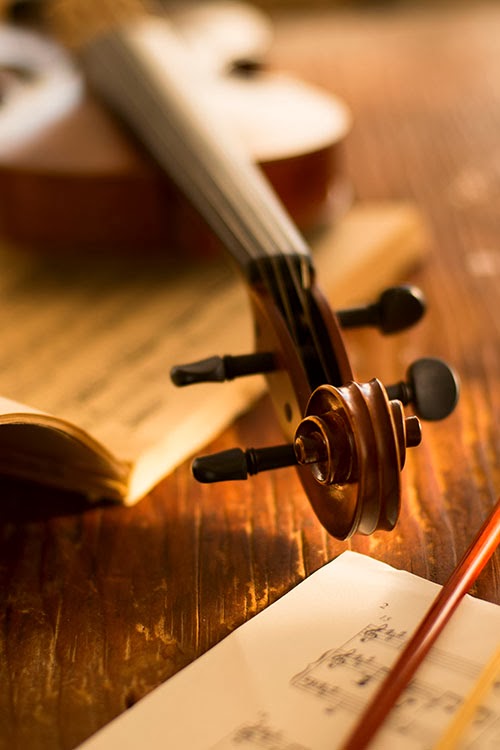 |
| This is a more subtle and practical application of a tilt. In the photo above only the end of the violin is in focus with the 50mm lens set to f/1.4. For the photo below a slight forward tilt of the lens extends the focus down the strings and includes the foreground bow and sheet of music to add a some story-telling detail to the out of focus areas. In this case the adapter was also rotated slightly off axis to align it with the diagonal of the violin. |
 |
| This photo and the one below are more typical of a subtler use of the tilt feature in still life. Both were taken at f/1.4 aperture with the lens tilted slightly forward. The tilt adds more detail to the foreground objects and surface areas, while still keeping the background very soft. |

The tilt-shift lenses I have used by Nikon and Canon are very well made, but only the newer Canon model adds independent control over both tilt and shift movements. So you can tilt and shift it at the same time for ultimate control of perspective and focus. The Kipon model can tilt and shift, but the shift is only in one direction that is opposite to the tilt, meaning you cannot have a tilt and shift in the same direction -- not so good when photographing architecture or landscapes. This is not so much of an issue for anyone doing post-processing on the images, as it is easy to correct perspective distortion afterwards. It is not possible to correct for depth of field. In those situations it would be best to just use the tilt function to increase the focus and perform the perspective correction later.
I don't use a tilt-shift lens for architectural shots anymore because it is so easy to correct perspective in post-processing. Nonetheless, it is the primary use for this lens type so I thought I would include some examples.
Another use of the shift function is to use it for panoramas. With the camera on a tripod, one exposure is taken with the lens shifted to the left, and a second image is taken with the lens shifted to the right. To widen the panorama even more a third exposure can be taken in the middle with no shift. All the images are stitched together later in something like Photoshop or
ArcSoft Panorama Maker to make one wide panoramic scene.
 |
| These three exposures, each with a different shift, were used to create the panoramic image below |
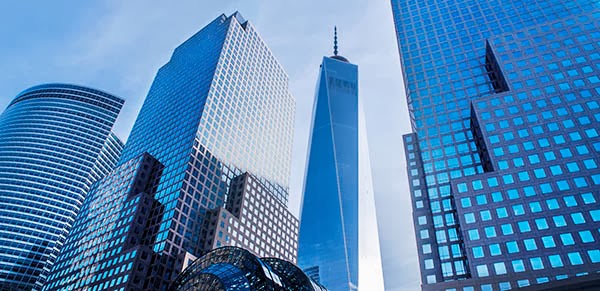 |
| This panorama of the new World Trade Center area is an assembly of three exposures done with the shift control -- one shot with left shift, one with no shift, and a third with right shift. The images were assembled in ArcSoft Panorama Maker 6 and some final perspective correction done in Photoshop. A side benefit of this technique is that you obtain larger resolution files to make enlarged prints. In this case, for instance, the resulting of combining the three images provides a 27mp file from the 16mp X-E2. |
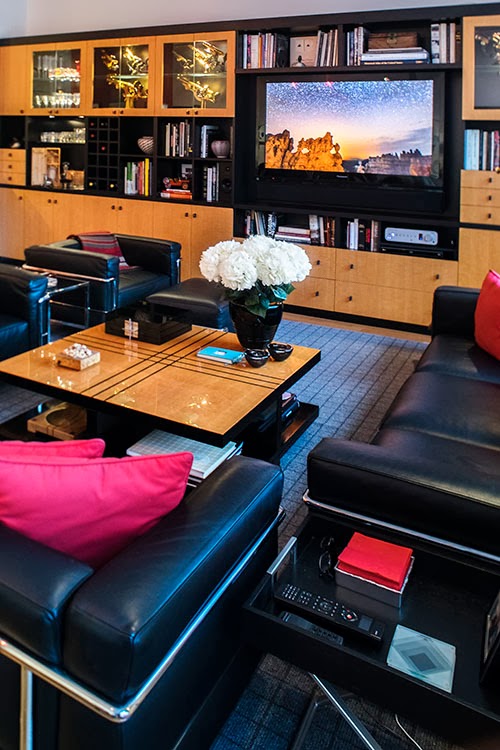 |
| For this interior image the adapter was used with a Nikon 20mm lens and has a downward shift to keep the room lines parallel while eliminating the ceiling and showing more of the bottom couches. In this case it would have been nice if the lens was able to tilt forward at the same time as the downward shift in order to increase the focus depth in the scene. Most professional tilt-shift lenses can do this. The Kipon adapter cannot. |
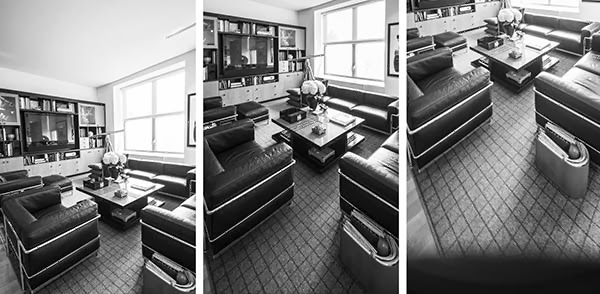 |
| These three views were taken with a 12mm focal length on a Sigma 12-24mm lens. On the left there is no correction made with the adapter. In the middle the lens was shifted down about half of its fill distance, which is about where I would want it for a shot like this. On the right the lens is shifted to the maximum distance allowed by the adapter. There is obvious image cutoff in this final image, but for practical purposes, as in the middle image, there is no vignetting. |
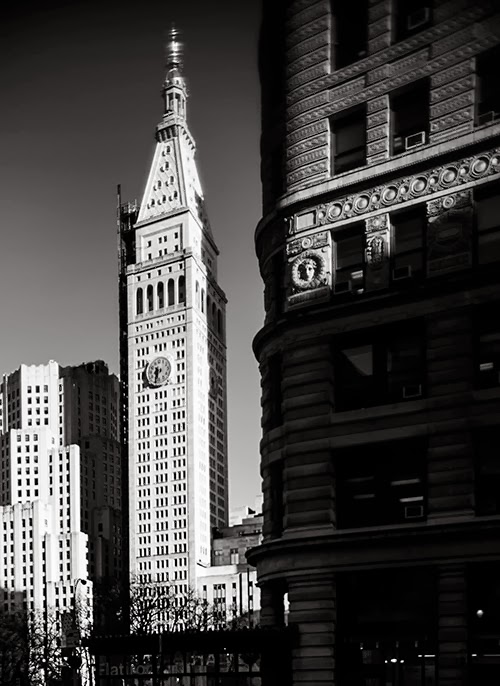 |
| Almost a full upward shift with a Nikon 20mm lens on the Kipon adapter fully corrects the perspective of the buildings.. |
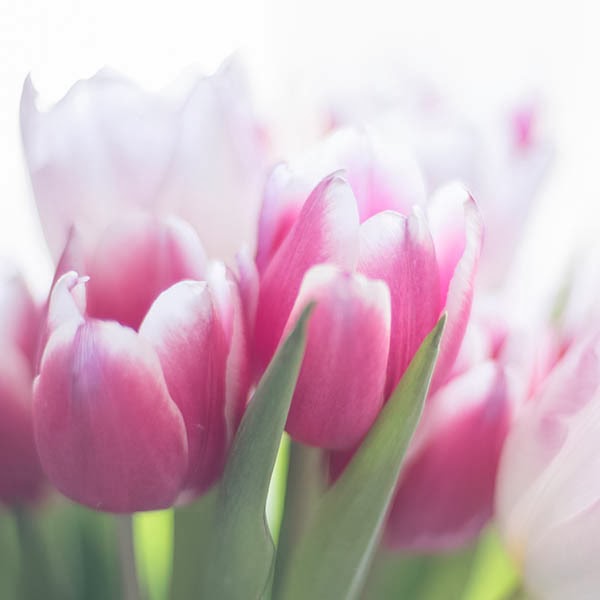 |
| This shot of tulips was taken with the Nikon 50mm f/1.4 at wide open aperture and no tilt on the Kipon adapter. Focus was placed on the petals of the larger tulip on to the right. Very little else is in focus. |
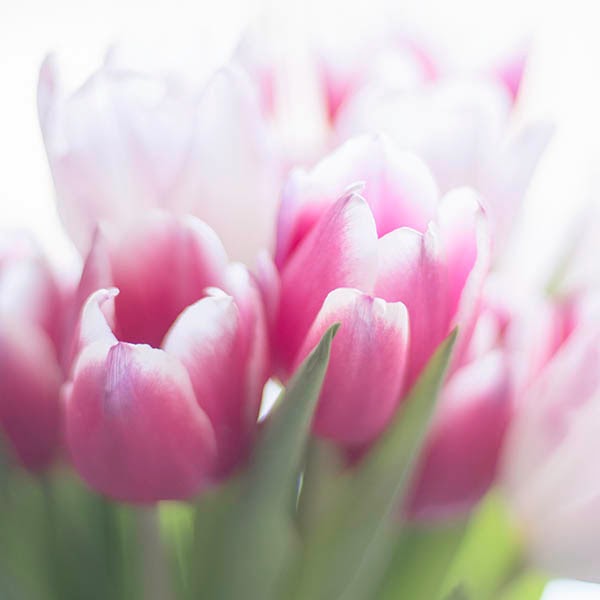 |
| For this version I tilted the lens forward slightly to extend the focus to more of the foreground tulip petals, and at the same time decrease it on the foreground leaves to soften them. Not everyone uses a tilt/shift for this subtle type of correction, but it is what I mostly do with it. |
Conclusion:For my purposes, namely using primarily the tilt function in still life applications, the Kipon adapter works perfectly fine on a Fuji X camera. I use it with Nikon D lenses, which I prefer because they have a manual aperture ring. Although there is another version of the adapter to accommodate Nikon G lenses, it doesn't allow you to see the exact aperture you are selecting when you use it.
For architectural photography, the adapter is handicapped by not allowing rotation of the tilt and shift mechanisms separate from each other.
A chief advantage to using an adapter as opposed to a dedicated tilt/shift lens is that the adapter can perform multiple duties by accepting a variety of focal lengths. Since the lenses being used were intended for a larger format sensor, their image coverage can cover a fuller area of the APS-C sensor when the lens is shifted. This may minimize vignetting a bit, although not entirely. A drawback is that it means working at the corners of the lens where the optical quality is not at its best. I found this to be especially true when I used the Nikon 20mm lens.
Bottom line is, the Kipon tilt-shift adapter is easy to use, works well given its limitations, and will do the job until a dedicated tilt-shift lens is added to the Fuji lens roadmap -- something I don't anticipate anytime in the near future.
The Kipon Tilt & Shift Adapter for Nikon F Lens to Fuji X-mount is now available here on Amazon.











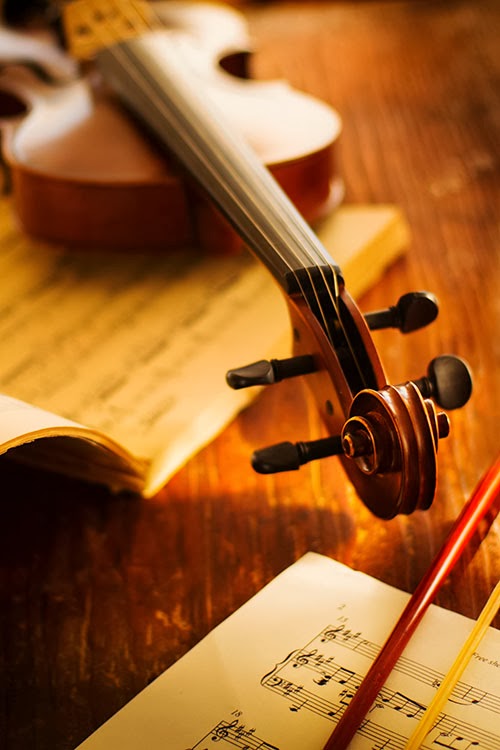











.jpg)














